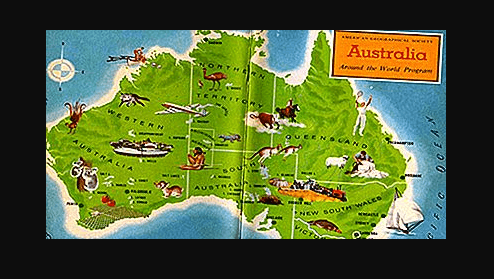Is Australia A Country
The difference between a continent and a country
Most people know which country they live in and which continent. But what exactly is the difference between them? A continent is a very large landmass, often separated by oceans. Some of these are separated by other geographical or social features. A geographical separation can be a narrow strip of land, while a social separation can be based on shared culture.

The rules that define continents are not firm. Typically, the world recognizes 7 different continents: North America, South America, Africa, Europe, Asia, Antarctica and Australia. Although some schools of thought combine North and South America into one group, thus creating 6 continents. Still, others, adhering to the theory of “one solid land mass”, believe that there are 4 continents: America, Afro-Eurasia, Antarctica and Australia.
However, a country is a separate political entity. In most cases, it has clearly defined edges that are the result of geographical features such as rivers and mountains or cultural boundaries. Constitutions and peace treaties formalize the location of these borders. According to recent figures, there are 206 sovereign countries in the world.
Is Australia a continent?
Geography of Australia
Australia consists of mainland Australia, Tasmania, Seram, New Guinea, sometimes Timor, and the surrounding islands. It is the smallest of the continents with an area of 3,310,000 square miles and is the lowest continent with human inhabitants. The nearby islands are connected to the continent by the continental shelf, including the Sahul Shelf and Bass Strait. About half of the continental shelf is found at 160 feet deep or less
Geology of Australia
Geologically, the Australian continent is found on the Indo-Australian plate. This plate separated from the supercontinent Gondwana around 96 million years ago. It moved away from Antarctica and headed north. Around 10,000 BC, the previous Ice Age ended and melting led to rising sea levels.
These rising waters eventually formed Bass Strait which separated Tasmania from the landmass. Between 2,000 and 4,000 later years, additional flooding created New Guinea and the Aru Islands, now north of the mainland. Australia is the only continent without active volcanic regions. over time, the tectonic plate of Australia and New Guinea collided with the Eurasian Plate. This collision resulted in the mountains of New Guinea and the islands of Wallacea.
Biodiversity of Australia
The northward drift of the Indo-Australian plate helped the continent to offset the global cooling trend. While other land masses were getting colder, the Australian continent was approaching closer to the equator, thus neutralizing the temperature changes. This temperature stability allowed the flora, fauna and fungi to evolve into special ecological roles. Its isolated position, in addition, prevented the influence of external species, allowing a unique development without competition.
Due to the lack of volcanoes and glaciers, the soil on the Australian continent was untouched and able to retain nutrients. This high degree of fertility-driven plant diversity allows for coevolution rather than divergent evolutions. The islands of Wallacea were close enough to the rainforests in Southeast Asia that some plants could reach in New Guinea. However, the Straits were too large to allow mammalian migration.
This combination of events has resulted in high levels of biodiversity and endemism on the continent today. Marsupials (mammals with pouches to carry their young) and monotremes (laying mammals) were able to dominate the placental mammals so common in other parts of the world. Many species of birds were able to evolve; scientists believe that songbirds first evolved on the Australian continent before migrating to other countries around the world.
Is Australia a country?
History of Australia
Indigenous people lived here, as they are descended from migrants who came to the area between 42,000 and 48,000 years ago, when Europeans first arrived. Dutch explorers landed on the Australian mainland in 1606 AD, mapped the northern and western coasts and named it New Holland. They did not establish settlements. In 1770, James Cook claimed the eastern shores for Great Britain and named it New South Wales. The British government established a penal colony here in 1783, an isolated settlement for prisoners. Additional settlers arrived in 1788 and formed what eventually became present-day Sydney.
The increasing number of European settlers led to additional settlements all over the mainland and as far away as Tasmania. The United Kingdom seized the West, dividing New South Wales into South Australia, Victoria and Queensland in the mid-1800s. The second half of the 19th century brought a gold rush and the colonies achieved a degree of autonomy as free settlers and penal colonies spread across the country, the indigenous population suffered as many as 1 million deaths from disease and conflict with the Europeans over the next 150 years.
By 1901, the colonies were established as the Commonwealth of Australia, a dominion of the British Empire. In 1931, the British government adopted the statute of Westminster, making the Legislature independent and making them sovereign nations.
Australia adopted the statute in 1942 and reverted it to 1939. After World War II, the country opened its borders to European immigrants, and in the 1970s to Asian immigrants (after the termination of the White Australia policy). The country severed all ties with the UK in 1986 and abolished the UK’s right to legislate in the Australian government.
Today the country consists of 6 states: New South Wales, Queensland, South Australia, Victoria, Western Australia and Tasmania. These are all on the mainland, with the exception of Tasmania and the island to the South. Neighboring countries are Papua New Guinea, Indonesia, East Timor, Solomon Islands, Vanuatu and New Zealand.
Population of Australia
The population of Australia is about 22.4 million. This number has grown exponentially since World War II, largely because the government encouraged immigration to the country. About 24.6% of the population is foreign-born and 43.1% have at least one, foreign-born parent. Indigenous Peoples make up 2.5% of the population. The total number of people in Australia is expected to nearly double by 2050.

